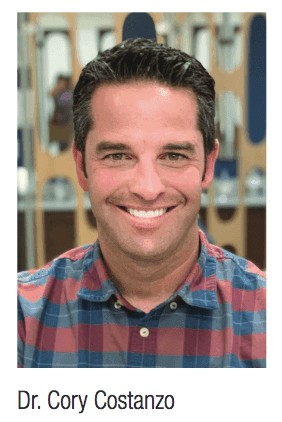Editor’s intro: Dr. Cory Costanzo’s insightful introduction advises orthodontists to adjust to the changing environment in the dental space to keep up with changes in technology, consumer mindsets, and optimal treatment options.
“It is not the most intellectual of the species that survives; it is not the strongest that survives; but the species that survives is the one that is able best to adapt and adjust to the changing environment in which it finds itself.”
 This quote is often misattributed to Charles Darwin, and while it may have been inspired by Darwin’s theories, it was actually written by Louisiana State University business professor Leon Megginson. Regardless of the author, it seems to appropriately describe the characteristics that one should possess in order to flourish in the technological revolution, which just about every industry is currently encountering. Taxi drivers are adapting to a world in which their services are hailed by a smartphone rather than an outstretched arm on the sidewalk. House cleaners are adapting to a world full of robotic vacuums. Orthodontists are adapting to a world in which patient treatment is designed on a computer and then delivered to the patient with the aid of 3D printing.
This quote is often misattributed to Charles Darwin, and while it may have been inspired by Darwin’s theories, it was actually written by Louisiana State University business professor Leon Megginson. Regardless of the author, it seems to appropriately describe the characteristics that one should possess in order to flourish in the technological revolution, which just about every industry is currently encountering. Taxi drivers are adapting to a world in which their services are hailed by a smartphone rather than an outstretched arm on the sidewalk. House cleaners are adapting to a world full of robotic vacuums. Orthodontists are adapting to a world in which patient treatment is designed on a computer and then delivered to the patient with the aid of 3D printing.
Of course, we’ve all heard “the only constant in life is change.” That quote goes all the way back to the Greek philosopher Heraclitus 500 B.C. This is certainly not the first time orthodontists have had to change. Edward Angle revolutionized how we deliver orthodontic treatment when he invented the edgewise appliance in the 1920s. Imagine being an orthodontist at that time. Imagine spending the previous 20 years mastering Angle’s E Arch appliance, only to have edgewise thrust upon you. I’m assuming there were those who resisted the new appliance. Resist or not, it wasn’t long before orthodontists adapted and embraced the technological benefits of edgewise, and the E Arch was relegated to a museum in St. Louis.
Now, thanks to intraoral scanners and sophisticated software, the edgewise appliance is jumping out of our hands and into the computer. Brackets are positioned digitally and delivered to the patient with a 3D-printed indirect bonding tray. Integration of CBCT with digital models allows us to visualize roots and simulate how they will move. Archwires are bent by computer-guided robots. Despite these improvements to the edgewise system, we may be approaching a time when the use of fixed appliances becomes scarce. It may not be long before clear removable appliances created from a digital plan are the norm.
Whether we choose to be on the leading edge, or perhaps more wisely follow closely behind, adapting to new technology can help maximize our ability to provide optimal treatment to our patients. We must, however, remain cautious as some advancements, like Internet-ordered DIY orthodontics, may simply be an attempt to maximize profits with little regard for patient health. Just about every orthodontist I know shares a common core value in that he/she is always striving to idealize both oral health and esthetics. We need to continue to let that value guide us as we evaluate the technology that we are presented with.
I’m reminded of a situation from my residency in the early 2000s. Computer-designed clear aligner therapy was in its infancy, and the chairman of our orthodontic department, Dr. Bob Boyd, was leading the charge. After a lecture he gave on the subject, someone in the audience came up and told him, “You’re ruining what we do.”
He calmly asked, “What is it that we do?”
The agitated spectator replied, “We bend wires.”
Dr. Boyd’s response, “Oh, I thought we gave people great smiles.”
Cory Costanzo, DDS
For the story of another orthodontist’s journey to advancement in the changing environment, read “How digital dreams become a reality,” by Dr. Andrew Nalin.
Stay Relevant With Orthodontic Practice US
Join our email list for CE courses and webinars, articles and mores


